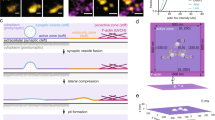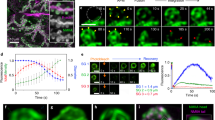Abstract
The actin cortex both facilitates and hinders the exocytosis of secretory granules. How cells consolidate these two opposing roles was not well understood. Here we show that antigen activation of mast cells induces oscillations in Ca2+ and PtdIns(4,5)P2 lipid levels that in turn drive cyclic recruitment of N-WASP and cortical actin level oscillations. Experimental and computational analysis argues that vesicle fusion correlates with the observed actin and Ca2+ level oscillations. A vesicle secretion cycle starts with the capture of vesicles by actin when cortical F-actin levels are high, followed by vesicle passage through the cortex when F-actin levels are low, and vesicle fusion with the plasma membrane when Ca2+ levels subsequently increase. Thus, cells employ oscillating levels of Ca2+, PtdIns(4,5)P2 and cortical F-actin to increase secretion efficiency, explaining how the actin cortex can function as a carrier as well as barrier for vesicle secretion.
This is a preview of subscription content, access via your institution
Access options
Subscribe to this journal
Receive 12 print issues and online access
$209.00 per year
only $17.42 per issue
Buy this article
- Purchase on Springer Link
- Instant access to full article PDF
Prices may be subject to local taxes which are calculated during checkout








Similar content being viewed by others
References
Morgan, A. & Burgoyne, R. D. Secretory granule exocytosis. Phys. Rev. 82, 581–632 (2003).
Orci, L., Gabbay, K. H. & Malaisse, W. J. Pancreatic β-cell web: its possible role in insulin secretion. Science 175, 1128–1130 (1972).
Cheek, T. R. & Burgoyne, R. D. Nicotine-evoked disassembly of cortical actin filaments in adrenal chromaffin cells. FEBS Lett. 207, 110–114 (1986).
Koffer, A., Tatham, P. E. & Gomperts, B. D. Changes in the state of actin during the exocytotic reaction of permeabilized rat mast cells. J. Cell Biol. 111, 919–927 (1990).
Chowdhury, H. H., Popoff, M. R. & Zorec, R. Actin cytoskeleton depolymerization with Clostridium spiroforme toxin enhances the secretory activity of rat melanotrophs. J. Physiol. 521, 389–395 (1999).
Frigeri, L. & Apgar, J. R. The role of actin microfilaments in the down-regulation of the degranulation response in RBL-2H3 mast cells. J. Immunol. 162, 2243–2250 (1999).
Becker, K. A. & Hart, N. H. Reorganization of filamentous actin and myosin-II in zebrafish eggs correlates temporally and spatially with cortical granule exocytosis. J. Cell Sci. 112, 97–110 (1999).
Nishida, K. et al. FcɛRI-mediated mast cell degranulation requires calcium-independent microtubule-dependent translocation of granules to the plasma membrane. J. Cell Biol. 170, 115–126 (2005).
Eichler, T. W., Kögel, T., Bukoreshtliev, N. V. & Gerdes, H-H. The role of myosin Va in secretory granule trafficking and exocytosis. Biochem. Soc. Trans. 34, 671–674 (2006).
Narasimhan, V., Holowka, D. & Baird, B. Microfilaments regulate the rate of exocytosis in rat basophilic leukemia cells. Biochem. Biophys. Res. Commun. 171, 222–229 (1990).
Li, G. et al. Effect of disruption of actin filaments by Clostridium botulinum C2 toxin on insulin secretion in HIT-T15 cells and pancreatic islets. Mol. Biol. Cell 5, 1199–1213 (1994).
Oheim, M. & Stühmer, W. Tracking chromaffin granules on their way through the actin cortex. Eur. Biophys. Journal 29, 67–89 (2000).
Lang, T. et al. Role of actin cortex in the subplasmalemmal transport of secretory granules in PC-12 cells. Biophys. J. 78, 2863–2877 (2000).
Nightingale, T. D. et al. Actomyosin II contractility expels von Willebrand factor from Weibel-Palade bodies during exocytosis. J. Cell Biol. 194, 613–629 (2011).
Masedunskas, A. et al. Role for the actomyosin complex in regulated exocytosis revealed by intravital microscopy. Proc. Natl Acad. Sci. USA 108, 13552–13557 (2011).
Rivera, J., Fierro, N. A., Olivera, A. & Suzuki, R. New insights on mast cell activation via the high affinity receptor for IgE. Adv. Immunol. 98, 85–120 (2008).
Kim, T. D., Eddlestone, G. T., Mahmoud, S. F., Kuchtey, J. & Fewtrell, C. Correlating Ca2+ responses and secretion in individual RBL-2H3 mucosal mast cells. J. Biol. Chem. 272, 31225–31229 (1997).
Johnson, H. W. & Schell, M. J. Neuronal IP3 3-kinase is an F-actin-bundling protein: role in dendritic targeting and regulation of spine morphology. Mol. Biol. Cell 20, 5166–5180 (2009).
Rak, G. D., Mace, E. M., Banerjee, P. P., Svitkina, T. & Orange, J. S. Natural killer cell lytic granule secretion occurs through a pervasive actin network at the immune synapse. PLoS Biol. 9, e1001151 (2011).
Lazarides, E. & Weber, K. Actin antibody: the specific visualization of actin filaments in non-muscle cells. Proc. Natl Acad. Sci. USA 71, 2268–2272 (1974).
Edelstein, A., Amodaj, N., Hoover, K., Vale, R. & Stuurman, N. Computer control of microscopes using microManager. Curr. Protoc. Mol. Biol. Unit14 20, 10.1002/0471142727.mb1420s92(2010).
Snapper, S. B. & Rosen, F. S. The Wiskott-Aldrich syndrome protein (WASP): roles in signaling and cytoskeletal organization. Annu. Rev. Immunol. 17, 905–929 (1999).
Ponti, A., Machacek, M., Gupton, S. L., Waterman-Storer, C. M. & Danuser, G. Two distinct actin networks drive the protrusion of migrating cells. Science 305, 1782–1786 (2004).
Giannone, G. et al. Periodic lamellipodial contractions correlate with rearward actin waves. Cell 116, 431–443 (2004).
Meyer, T. & Stryer, L. Calcium spiking. Annu. Rev. Biophys. Biophys. Chem. 20, 153–174 (1991).
Chapman, E. R. Synaptotagmin: a Ca(2+) sensor that triggers exocytosis?. Nat. Rev. Mol. Cell Biol. 3, 498–508 (2002).
Papayannopoulos, V. et al. A polybasic motif allows N-WASP to act as a sensor of PIP(2) density. Mol. Cell 17, 181–191 (2005).
Janmey, P. A. & Lindberg, U. Cytoskeletal regulation: rich in lipids. Nat. Rev. Mol. Cell Biol. 5, 658–666 (2004).
Suh, B. C., Inoue, T., Meyer, T. & Hille, B. Rapid chemically induced changes of PtdIns(4,5)P2 gate KCNQ ion channels. Science 314, 1454–1457 (2006).
Sheetz, M. P., Sable, J. E. & Dobereiner, H. G. Continuous membrane-cytoskeleton adhesion requires continuous accommodation to lipid and cytoskeleton dynamics. Ann. Rev. Biophys. Biomol. Struct. 35, 417–434 (2006).
Acknowledgements
This work was supported by NIH grants MH064801 and GM030179 to T.M.
Author information
Authors and Affiliations
Contributions
T.M. and R.W. designed experiments and wrote the manuscript. R.W. performed all experiments and data analysis.
Corresponding author
Ethics declarations
Competing interests
The authors declare no competing financial interests.
Supplementary information
Supplementary Information
Supplementary Information (PDF 1627 kb)
Supplementary Note
Supplementary Information (PDF 85 kb)
Supplementary Movie 1
Supplementary Information (MOV 2341 kb)
Supplementary Movie 2
Supplementary Information (MOV 7932 kb)
Supplementary Movie 3
Supplementary Information (MOV 789 kb)
Supplementary Movie 4
Supplementary Information (MOV 10472 kb)
Supplementary Movie 5
Supplementary Information (MOV 9063 kb)
Supplementary Movie 6
Supplementary Information (AVI 15448 kb)
Supplementary Movie 7
Supplementary Information (AVI 18550 kb)
Supplementary Table 1
Supplementary Information (XLSX 158 kb)
Supplementary Data
Supplementary Information (TXT 1 kb)
Rights and permissions
About this article
Cite this article
Wollman, R., Meyer, T. Coordinated oscillations in cortical actin and Ca2+ correlate with cycles of vesicle secretion. Nat Cell Biol 14, 1261–1269 (2012). https://doi.org/10.1038/ncb2614
Received:
Accepted:
Published:
Issue Date:
DOI: https://doi.org/10.1038/ncb2614
This article is cited by
-
Oligodendrocyte calcium signaling promotes actin-dependent myelin sheath extension
Nature Communications (2024)
-
Rescuing SERCA2 pump deficiency improves bone mechano-responsiveness in type 2 diabetes by shaping osteocyte calcium dynamics
Nature Communications (2024)
-
Intestinal mucus components and secretion mechanisms: what we do and do not know
Experimental & Molecular Medicine (2023)
-
100 Hz ROCS microscopy correlated with fluorescence reveals cellular dynamics on different spatiotemporal scales
Nature Communications (2022)
-
HEM1 Actin Immunodysregulatory Disorder: Genotypes, Phenotypes, and Future Directions
Journal of Clinical Immunology (2022)



